Search Result
Results for "
DU145
" in MedChemExpress (MCE) Product Catalog:
| Cat. No. |
Product Name |
Target |
Research Areas |
Chemical Structure |
-
- HY-145312
-
|
|
ATM/ATR
|
Cancer
|
|
ATR-IN-4 is a potent ATR (Ataxia telangiectasia mutated gene Rad 3-associated kinase) inhibitor. ATR-IN-4 inhibits growth of human prostate cancer cells DU145 and human lung cancer cells NCI-H460 with IC50s of 130.9 nM and 41 .33 nM, respectively. (Patent CN112142744A, compound 13) .
|
-

-
- HY-12842
-
|
|
IAP
Apoptosis
|
Cancer
|
|
UC-112 is a novel potent IAP(Inhibitor of apoptosis) inhibitor; potently inhibit cell growth in two human melanoma (A375 and M14) and two human prostate (PC-3 and DU145) cancer cell lines(IC50=0.7-3.4 uM).
|
-
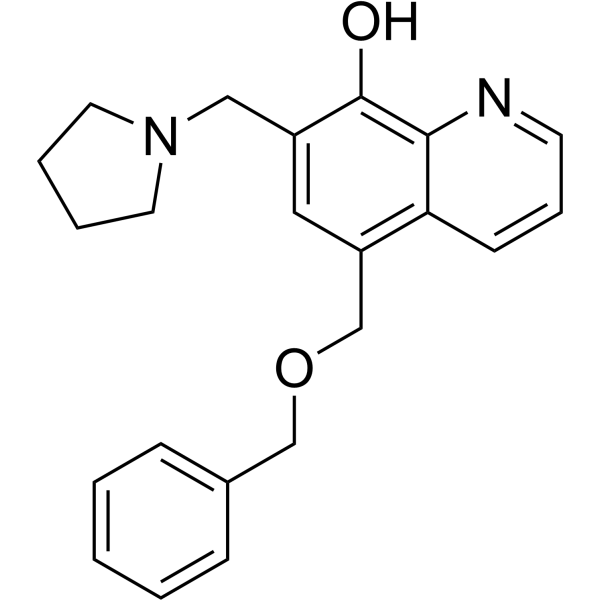
-
- HY-N1252
-
|
|
|
|
|
Scillascillin (compound 10) is a homoisoflavanone. Scillascillin can be isolated from S. scilloides. Scillascillin shows anticancer activity towards MCF-7 (breast cancer) and DU-145 (prostate cancer) cells with the IC50 of 9.59 and 11.32 ug/ml, respectively .
|
-
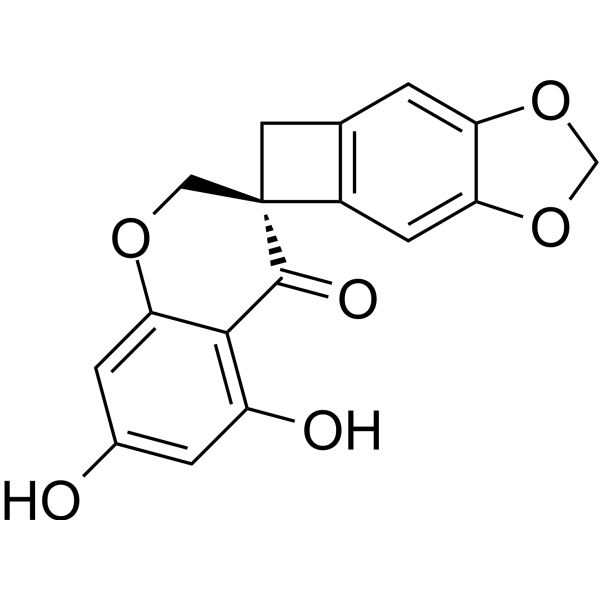
-
- HY-147734
-
|
|
Others
|
Cancer
|
|
Calpain inhibitors are lipophilic and show moderate to good antiproliferative activity in vitro compared with melanoma cell lines (a-375 and b-16f1) and PC-3 prostate cancer cells. In addition, a member of this group (compound 3) expressed 2 μ M concentration inhibited the invasion of DU-145 cells by 80%.
|
-
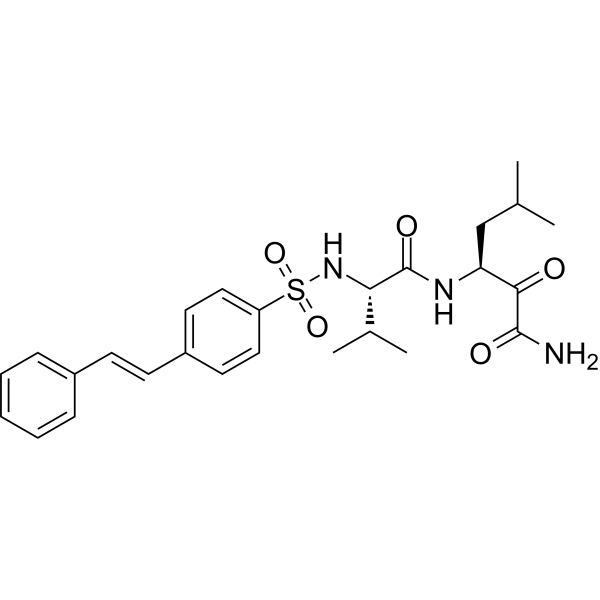
-
- HY-N8270
-
|
|
Hedgehog
Endogenous Metabolite
|
Cancer
|
|
Physalin H is a natural product that can be isolated from Solanum nigrum. Physalin H is an inhibitor of Hedgehog (Hh) signaling and it disrupts GLI1-DNA-complex formation. Physalin H inhibits GLI1 transcription with an IC50 value of 0.7 μM. Physalin H shows cytotoxicity to PANC1 and DU145 cells with IC50 values of 5.7 and 6.8 μM, respectively .
|
-
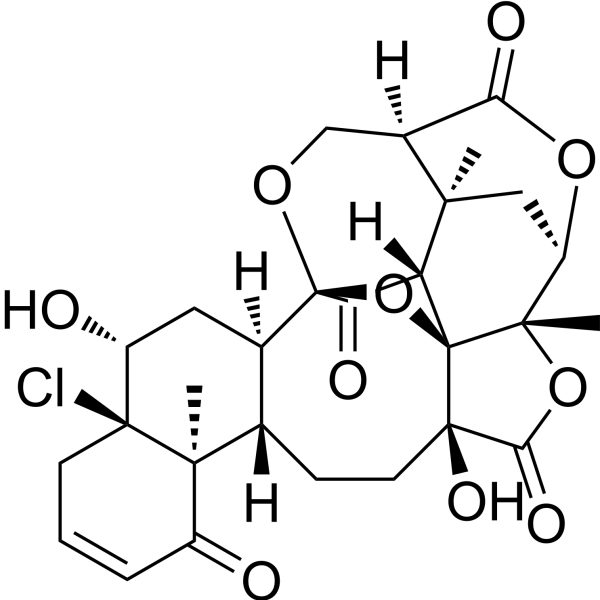
-
- HY-155982
-
|
|
STAT
|
Cancer
|
|
STAT3-IN-20 (Compound 40) is a selective STAT3 inhibitor (IC50: 0.65 μM). STAT3-IN-20 binds the SH2 domain to inhibit STAT3 phosphorylation, translocation, and downstream gene transcription. STAT3-IN-20 exhibits antiproliferative activities against STAT3-overactivated DU145 and MDA-MB-231 cancer cells (IC50: 2.97 μM and 3.26 μM respectively). STAT3-IN-20 induces cell cycle arrest and apoptosis .
|
-
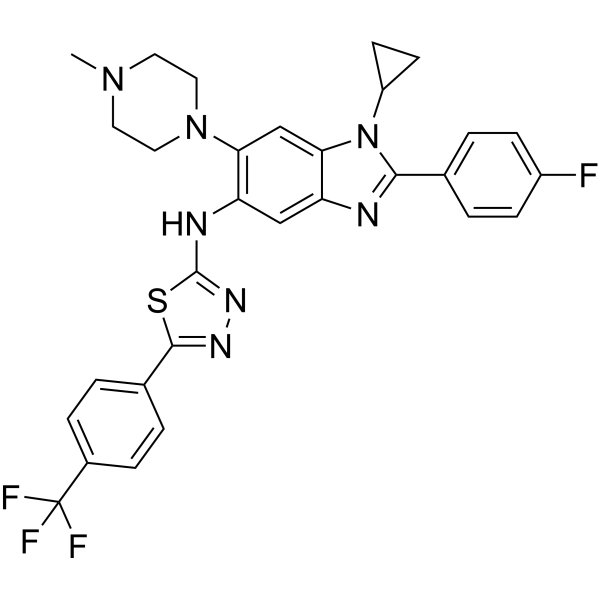
-
- HY-119257
-
|
|
Farnesyl Transferase
Apoptosis
|
Cancer
|
|
ABT-100 is a potent, highly selective and orally active farnesyltransferase inhibitor. ABT-100 inhibits cell proliferation (IC50s of 2.2 nM, 3.8 nM, 5.9 nM, 6.9 nM, 9.2 nM, 70 nM and 818 nM for EJ-1, DLD-1, MDA-MB-231, HCT-116, MiaPaCa-2, PC-3, and DU-145 cells, respectively), increases apoptosis and decreases angiogenesis. ABT-100 possesses broad-spectrum antitumor activity .
|
-
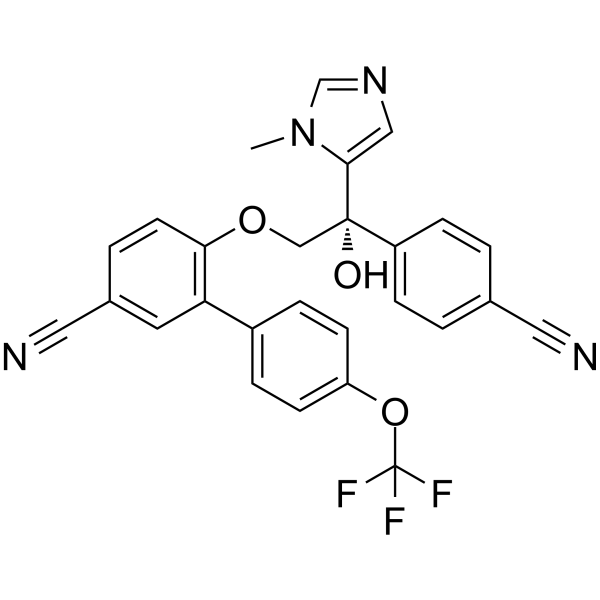
-
- HY-N10778
-
|
|
Others
|
Others
|
|
(19R,23E)-5b,19-Epoxy19-ethoxycucurbita-6,23-diene-3b,25-diol is a cucurbitane-type triterpenoid. (19R,23E)-5b,19-Epoxy19-ethoxycucurbita-6,23-diene-3b,25-diol has been tested to no effect against 5 cancer cell lines, MCF-7, HepG2, Du145, Colon205 and HL-60 by MTT assay .
|
-
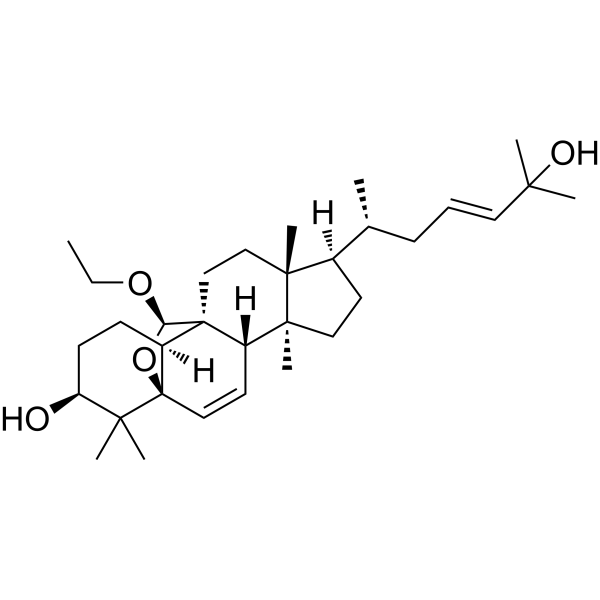
-
- HY-103711
-
|
|
Microtubule/Tubulin
|
Cancer
|
|
Estramustine is an antineoplastic agent. Estramustine depolymerizes microtnbules by binding to tubulin 1, exhibits antimitotic activity with an IC50 value of ~16 μM for mitosis of DU 145 cells. Estramustine blocks cells at mitosis in prostate tumor xenografts .
|
-
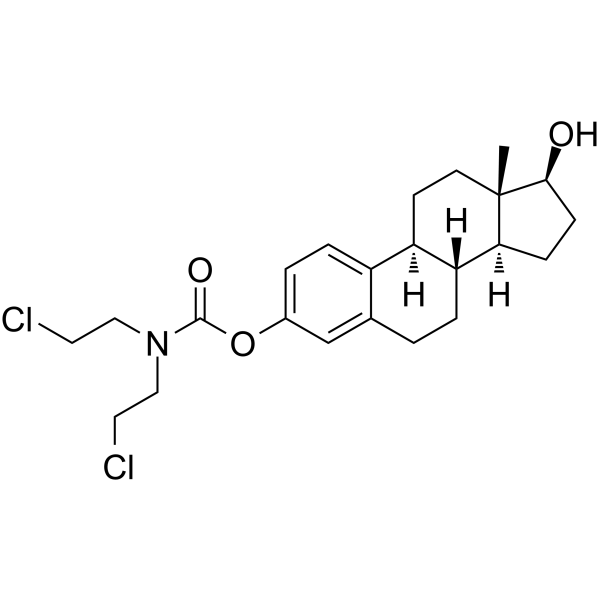
-
- HY-119694
-
|
|
Others
|
Cancer
|
|
Rotenolone is an antiproliferative agent. Rotenolone shows antiproliferative activity against the ovarian cancer A2780, breast cancer BT-549, prostate cancer DU 145, NSCLC NCI-H460, and colon cancer HCC-2998 cell lines, with IC50s of 0.95, 1.6, 2.7, 2.0, and 2.9 μM, respectively .
|
-
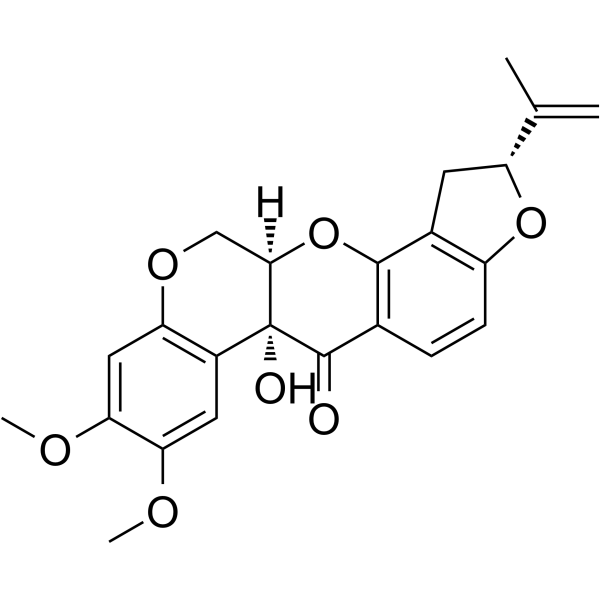
-
- HY-144667
-
|
|
Aldehyde Dehydrogenase (ALDH)
|
Cancer
|
|
ALDH1A3-IN-1 (Compound 14) is a potent ALDH1A3 inhibitor, with an IC50 of 0.63 µM and a Ki of 0.46 µM. ALDH1A3-IN-1 can be studied in prostate cancer .
|
-
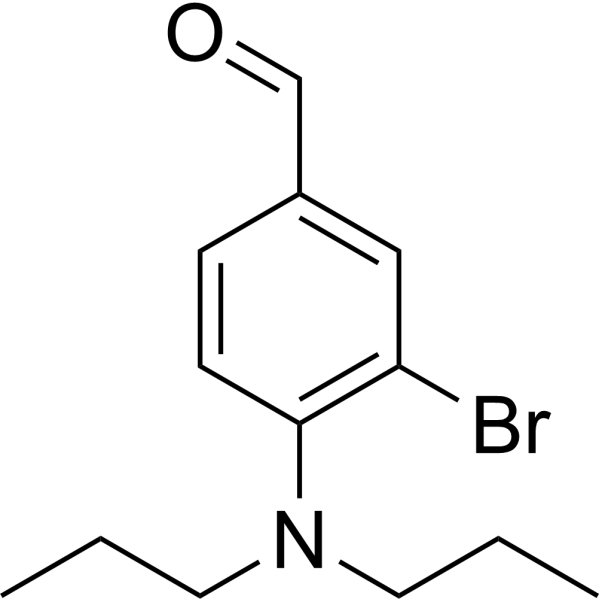
-
- HY-N2415
-
|
|
Microtubule/Tubulin
|
Cancer
|
|
Podophyllotoxone is isolated from the roots of Dysosma versipellis and has anti-cancer activities.Podophyllotoxone is able to inhibit the tubulin polymerization .
|
-
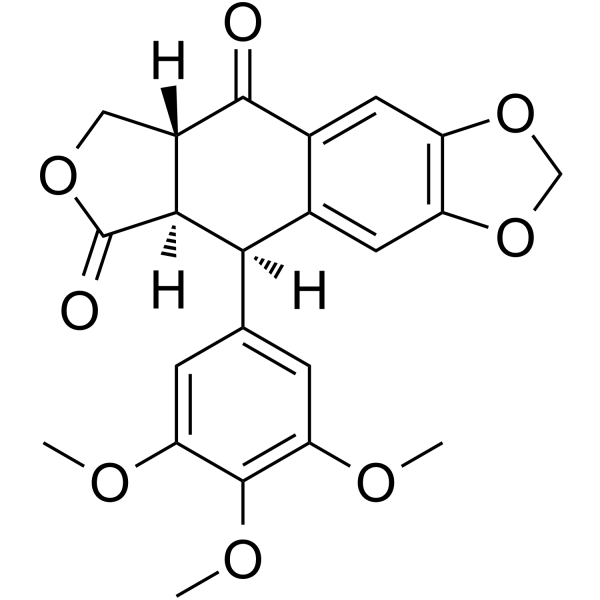
-
- HY-133219
-
|
|
Topoisomerase
|
Cancer
|
|
Guajadial C is a Top1 catalytic inhibitor that delays Top1 poison-mediated DNA damage. Guajadial C shows cytotoxicity against cancer cells .
|
-

-
- HY-123524
-
|
|
STAT
|
Cancer
|
|
STAT3-IN-4 (compound B9) is a STAT3 inhibitor with Kd values for STAT3 (I634S/Q635G) and WT are 22.75 and 4.59 μM, respectively. STAT3-IN-4 can inhibit the proliferation of tumor cells .
|
-
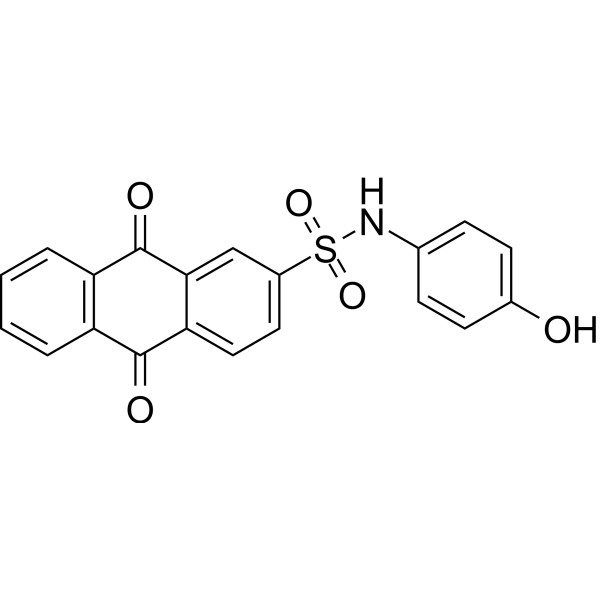
-
- HY-146027
-
|
|
Androgen Receptor
|
Cancer
|
|
Androgen receptor antagonist 4 (Compound AT2) is an androgen receptor (AR) antagonist with an IC50 of 0.15 μM. Androgen receptor antagonist 4 efficiently antagonizes AR transcriptional activity, suppresses downstream target gene of AR, and blocks the DHT-induced AR nuclear translocation. Androgen receptor antagonist 4 shows anticancer activities .
|
-
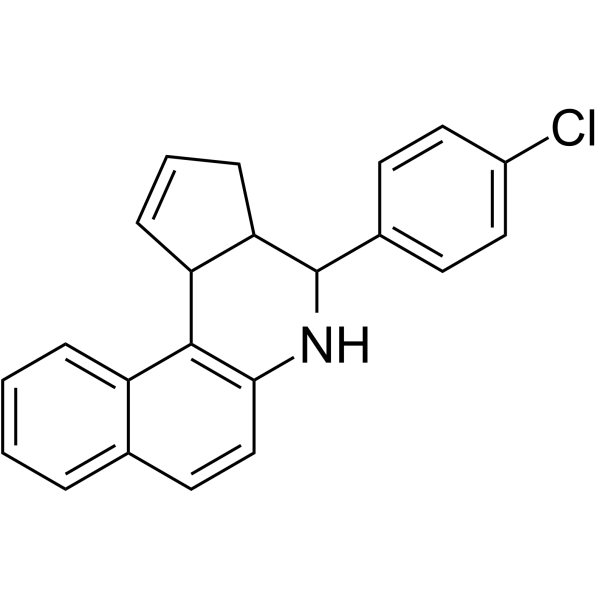
-
- HY-146026
-
|
|
Androgen Receptor
|
Cancer
|
|
Androgen receptor antagonist 3 (Compound C18) is an androgen receptor (AR) antagonist with an IC50 of 2.4 μM. Androgen receptor antagonist 3 shows anticancer activities .
|
-
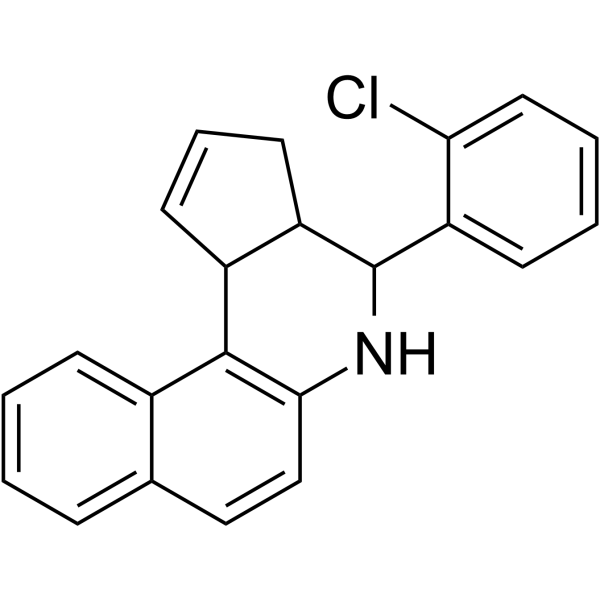
-
- HY-128172
-
|
NBA
|
TRP Channel
|
Cancer
|
|
TRPM4-IN-2 (NBA) is a potent transient receptor potential melastatin 4 (TRPM4) inhibitor with an IC50 value of 0.16 μM. TRPM4-IN-2 can be used for researching prostate cancer and colorectal cancer .
|
-
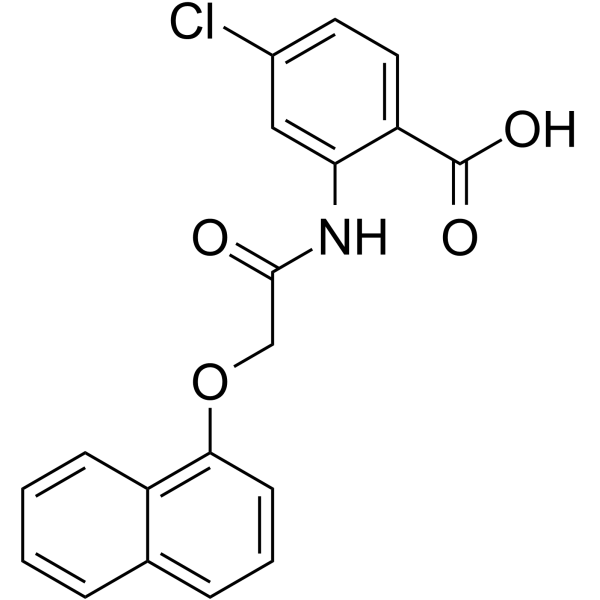
-
- HY-N10491
-
|
|
P-glycoprotein
|
Cancer
|
|
Spongionellol A is a MDR1 (p-glycoprotein) inhibitor. Spongionellol A has high cytotoxic activity and selectivity in prostate cancer cells by inducing caspase‑dependent apoptosis. Spongionellol A can be used in the research of cancers, such as prostate cancer .
|
-

-
- HY-N10492
-
|
|
P-glycoprotein
|
Cancer
|
|
Spongionellol A analog 1, an analog of Spongionellol A (HY-10491), is a MDR1 (p-glycoprotein) inhibitor. Spongionellol A analog 1 has high cytotoxic activity and selectivity in prostate cancer cells by inducing caspase‑dependent apoptosis. Spongionellol A analog 1 can be used in the research of cancers, such as prostate cancer .
|
-
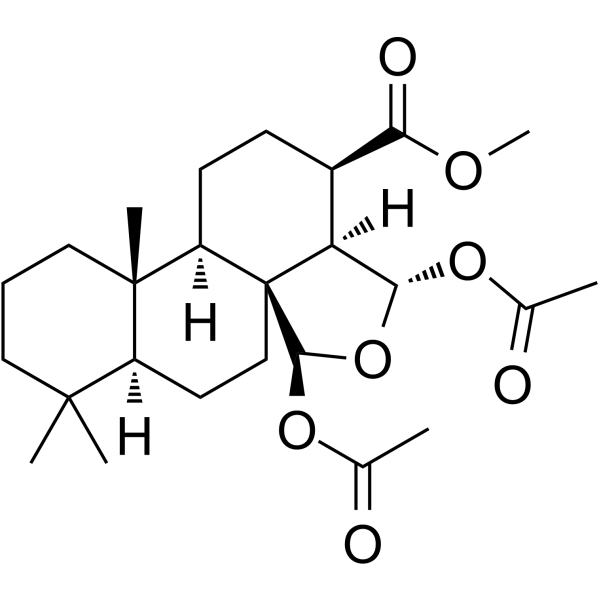
-
- HY-16375
-
|
D-63153
|
GnRH Receptor
Apoptosis
|
Cancer
|
|
Ozarelix (D-63153) is a GnRH antagonist. Ozarelix induces cell apoptosis and arrests cell in G2/M phase. Ozarelix can be used in the research of prostate cancer .
|
-

-
- HY-122943
-
|
|
Fungal
Apoptosis
|
Infection
Cancer
|
|
Moracin D is a flavonoid that can be isolated from Morus alba. Moracin D induces cell apoptosis and shows hypoglycemic, antiadipogenic, antifungal and antitumor effects. Moracin D can be used for fungal infection and breast cancer research .
|
-
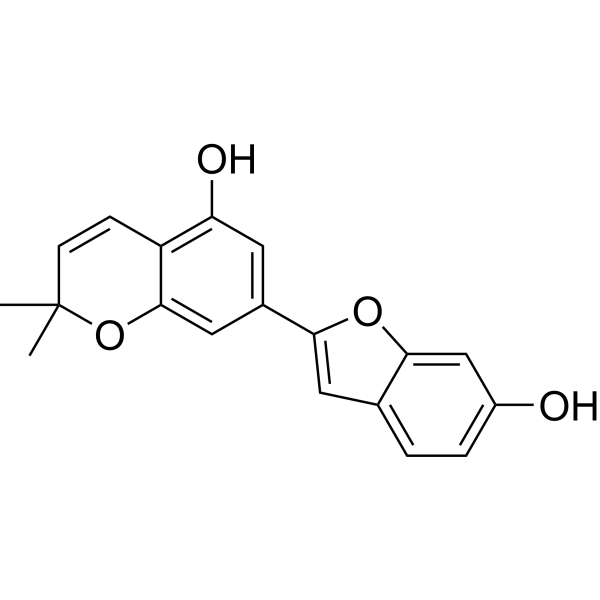
-
- HY-162370
-
|
|
Cytochrome P450
|
Infection
Cancer
|
|
CYP51-IN-16 (compound C6) is a phenylpyrimidine CYP51 inhibitor, and shows antifungal activity in in vitro. CYP51-IN-16 inhibits tumor cell growth .
|
-
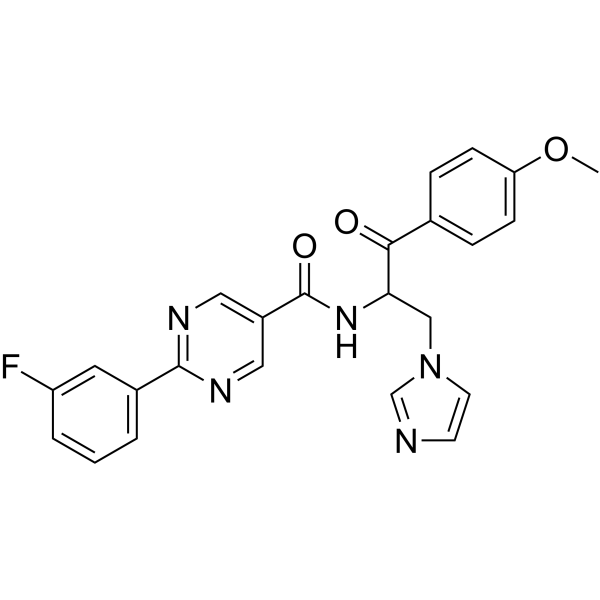
-
- HY-B2163
-
|
|
PPAR
Reactive Oxygen Species
STAT
NF-κB
Apoptosis
|
Cardiovascular Disease
Metabolic Disease
Cancer
|
|
Astaxanthin, the red dietary carotenoid, is an orally effective and potent antioxidant. Astaxanthin inhibits NF-κB and down-regulates VEGF in blood glucose. Astaxanthin exerts anti-cancer cell proliferation, increases apoptosis, impairs migration and invasion by activating PPARγ and reducing the expression of STAT3. Astaxanthin also has neuroprotective and anti-inflammatory activity and can be used in studies of cancer, diabetic retinopathy, cardiovascular disease, and in the coloring of animal feed .
|
-

-
- HY-150591
-
|
|
Proteasome
|
Cancer
|
|
20S Proteasome-IN-3 is a 20S proteasome β5 subunit inhibitor (IC50=1.64 μM) . 20S Proteasome-IN-3 shows anti-tumor proliferation activity .
|
-
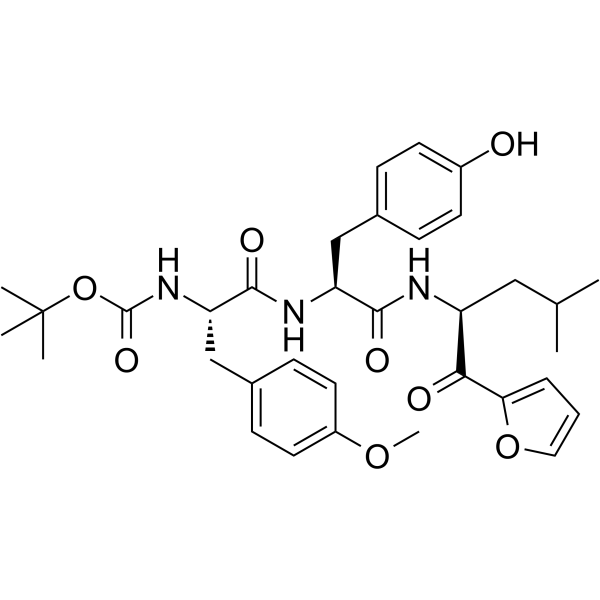
-
- HY-P99183
-
|
EMD 525797; DI17E6
|
Integrin
|
Cancer
|
|
Abituzumab (DI17E6) is a humanised anti-integrin αV monoclonal antibody (IgG2 type). Abituzumab effectively reduces the phosphorylation of FAK, Akt and ERK. Abituzumab can be used in cancer research, particularly in prostate cancer .
|
-

-
- HY-113574
-
|
|
HSP
|
Cancer
|
|
HSP90-IN-29 (Compound 13), a benzoxazole derivative, is a potent and selective HSP-90 inhibitor with an IC50 value of 30 nM. HSP90-IN-29 has antitumor activity .
|
-
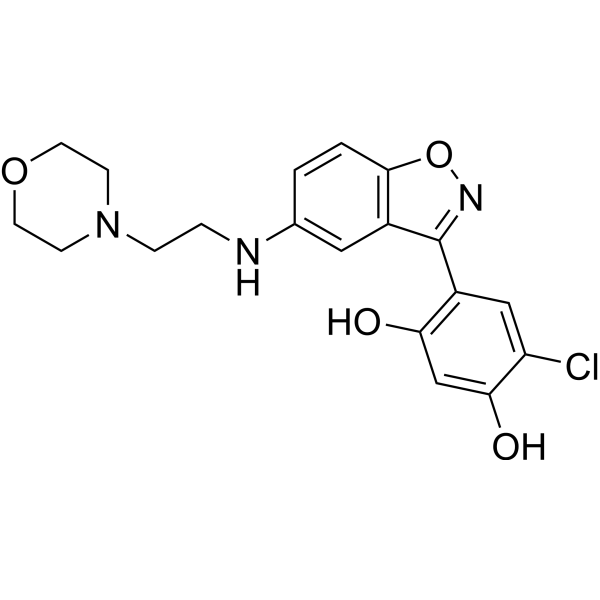
-
- HY-114657A
-
|
|
Arp2/3 Complex
|
Inflammation/Immunology
Cancer
|
|
Benproperine phosphate is an orally active, potent actin-related protein 2/3 complex subunit 2 (ARPC2) inhibitor. Benproperine phosphate attenuates the actin polymerization rate of action polymerization nucleation by impairing Arp2/3 function. Benproperine phosphate has the potential for a cough suppressant and suppresses cancer cell migration and tumor metastasis .
|
-
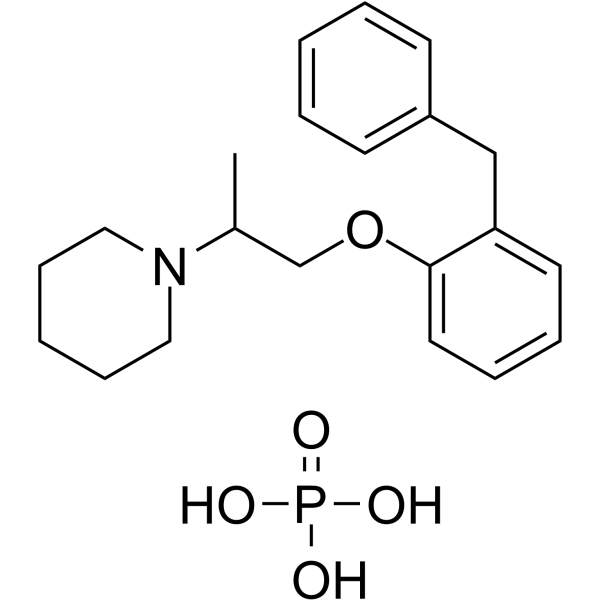
-
- HY-16187
-
|
|
HIF/HIF Prolyl-Hydroxylase
Apoptosis
|
Cancer
|
|
EL-102 is a hypoxia-induced factor 1 (Hif1α) inhibitor. EL-102 induces apoptosis, inhibits tubulin polymerisation and shows activities against prostate cancer. EL-102 can be used for the research of cancer .
|
-
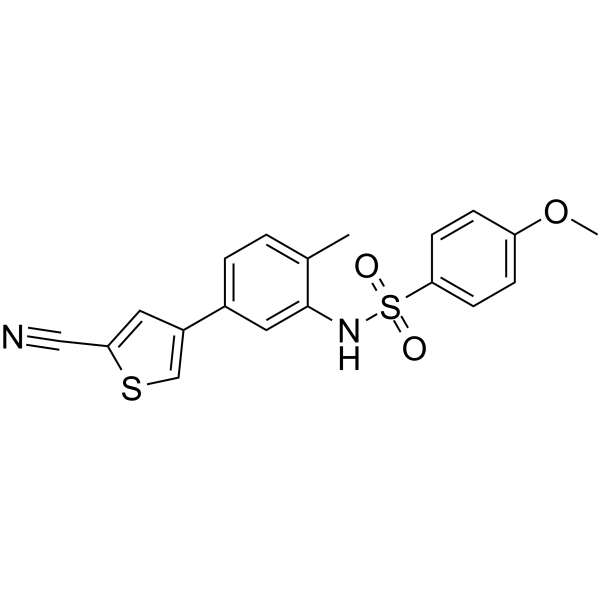
-
- HY-157388
-
|
|
Histone Methyltransferase
HDAC
|
Cancer
|
|
CARM1/HDAC2-IN-1 (compound CH-1) is a dual inhibitor against CARM1 and HDAC2, with IC50 values of 3.71 nM and 4.07 nM, respectively. CARM1/HDAC2-IN-1 possesses antitumor activity .
|
-

-
- HY-161385
-
|
|
Topoisomerase
|
Cancer
|
|
Topoisomerase I inhibitor 21 (Compound 3e) is an inhibitor for Topoisomerase I through stabilization of enzyme-DNA complex. Topoisomerase I inhibitor 21 exhibits antiproliferative activity in 39 human cancer cells (JFCR39) with mean GI50 39 nM .
|
-
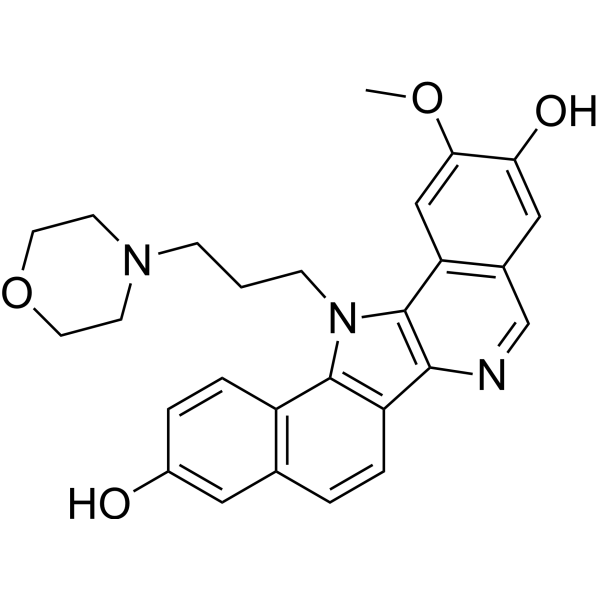
-
- HY-19960
-
BCTC
2 Publications Verification
|
TRP Channel
Insulin Receptor
CGRP Receptor
|
Neurological Disease
Metabolic Disease
Cancer
|
|
BCTC is an orally active current inhibitor of vanilloid receptor type 1 (VR1). BCTC is a transient receptor potential cation channel subfamily M member 8 (TRPM8) and transient receptor potential vanilloid 1 (TRPV1) antagonist. BCTC is an insulin sensitizer and secretor. BCTC has anticancer and analgesic effects .
|
-

-
- HY-N2959
-
|
|
JAK
STAT
Apoptosis
Autophagy
|
Cancer
|
|
Brevilin A is an orally active STAT3/JAK inhibitor (STAT3 IC50= 10.6 µM). Brevilin A shows anti-tumor activity, anti-proliferative activity to cancer cells, and can induce apoptosis and autophagy .
|
-

-
- HY-108986
-
|
|
Sirtuin
SARS-CoV
|
Cancer
|
|
JFD00244 is a sirtuin 2 (SIRT2) inhibitor, with anti-tumor effect. JFD00244 is also a Nsp-16 inhibitor against SARS-CoV-2 .
|
-
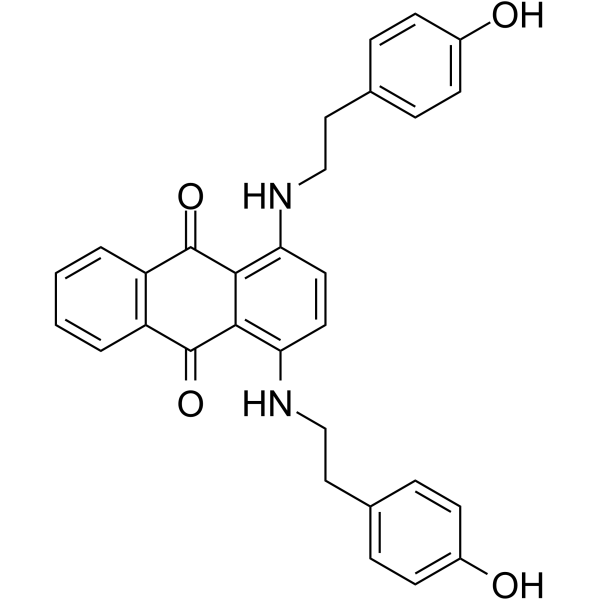
-
- HY-15792
-
|
10,11-(Methylenedioxy)-20(R)-camptothecin
|
Others
|
Cancer
|
|
(R)-FL118 (10,11-(Methylenedioxy)-20(R)-camptothecin) is the R-enantiomer of FL118 (HY-12486). (R)-FL118 shows anticancer activity .
|
-

-
- HY-116107
-
|
|
Necroptosis
|
Cancer
|
|
AG311 is an anticancer and antimetastatic agent. AG311 induces rapid necrosis in numerous cancer cell lines .
|
-
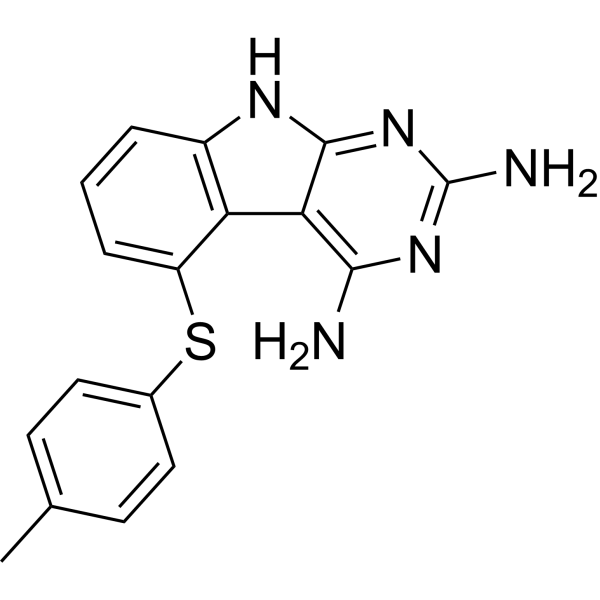
-
- HY-146393
-
|
|
PROTACs
Cytochrome P450
|
Cancer
|
|
PROTAC CYP1B1 degrader-1 (Compound 6C), a α-naphthoflavone chimera derivative, is able to eliminate cytochrome P450 (CYP)1B1-mediated agent resistance via targeted CYP1B1 degradation, with IC50s of 95.1 and 9838.6 nM for CYP1B1 and CYP1A2, respectively. PROTAC CYP1B1 degrader-1 can be used for the research of CYP1B1-overexpressing prostate cancer .
|
-

-
- HY-119833
-
|
|
MicroRNA
|
Cancer
|
|
Rubone, a chalcone analog, is a modulator of miR-34a. Rubone upregulates miR-34a expression in a p53 dependent manner, downregulates the downstream target Bcl-2 and Cyclin D1 expression, and suppresses hepatocellular carcinoma (HCC) growth in vivo. Rubone enhances the anticancer effect of Paclitaxel (PTX; HY-B0015) in PTX-resistant prostate cancer cell lines by reversing the expression of miR-34a downstream targets .
|
-
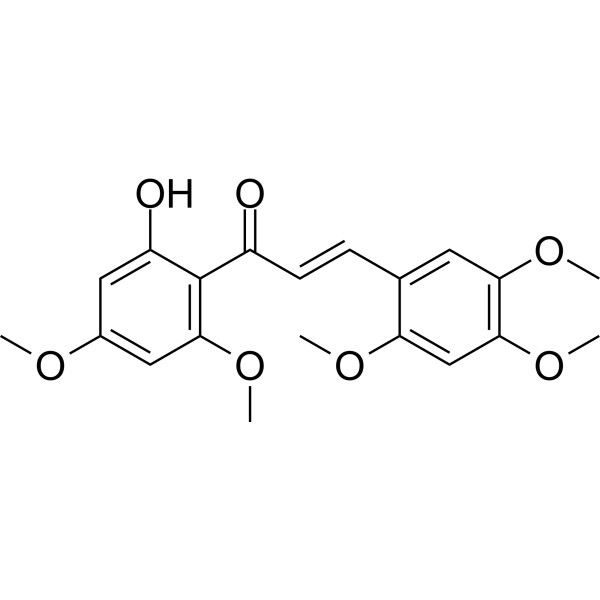
-
- HY-14454
-
TPh A
1 Publications Verification
Triphenyl Compound A
|
Others
|
Cancer
|
|
TPh A (Triphenyl Compound A) is a potent inhibitor of the nuclear protein pirin and binds specifically to pirin with a Ki of 0.6 uM. TPh A disrupts the formation of the bcl3–pirin complex. TPh A can be used as a novel small molecule tool to regulate pirin in cells .
|
-
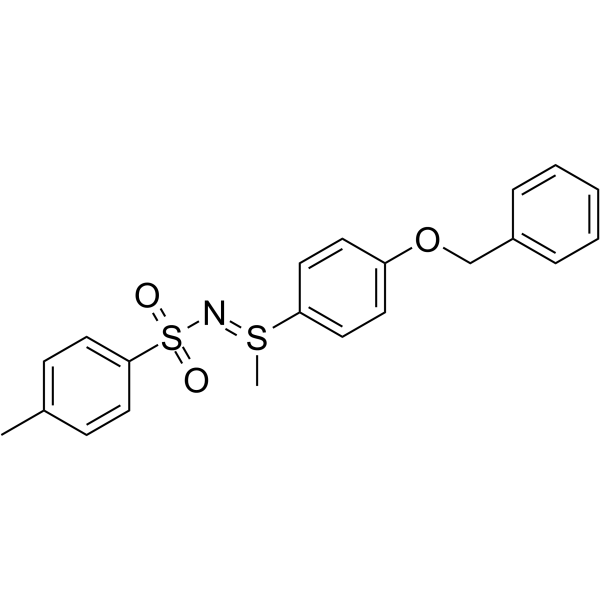
-
- HY-163340
-
|
|
Glucocorticoid Receptor
Androgen Receptor
|
Cancer
|
|
GA32 (compound 58r) is potent androgen receptor (AR)/glucocorticoid receptor (GR) dual inhibitor with IC50 values of 0.13 μM and 0.83 μM for AR and GR, respectively. GA32 inhibits the proliferation of Enzalutamide (HY-70002) resistance castration-resistant prostate cancer both in vitro and in vivo .
|
-
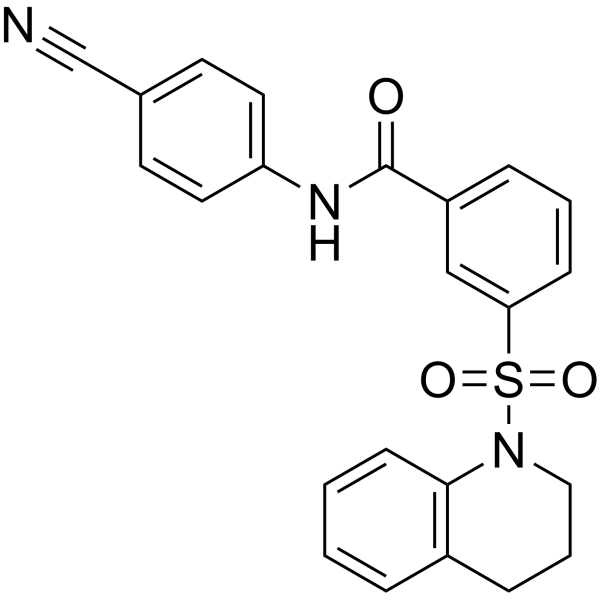
-
- HY-A0068
-
|
Gold thioglucose
|
NF-κB
HIV
Reactive Oxygen Species
|
Infection
Inflammation/Immunology
Cancer
|
|
Aurothioglucose (Gold thioglucose), containing monovalent gold ion, is a potent active-site inhibitor of TrxR1 (thioredoxin reductase 1), with an IC50 of 65 nM. Aurothioglucose inhibits the DNA binding of NF-κB in vitro. Aurothioglucose shows anti-HIV and anti-rheumatic activities .
|
-

| Cat. No. |
Product Name |
Target |
Research Area |
-
- HY-P2284
-
|
|
Peptides
|
Cancer
|
|
AD 01, a 24 amino acid peptide of FKBPL (FK506-binding protein like), possesses potent anti-angiogenic activity. AD 01 bind to the CD44 receptor and inhibit tumour cell migration in a CD44 dependant manner .
|
-
- HY-16375
-
|
D-63153
|
GnRH Receptor
Apoptosis
|
Cancer
|
|
Ozarelix (D-63153) is a GnRH antagonist. Ozarelix induces cell apoptosis and arrests cell in G2/M phase. Ozarelix can be used in the research of prostate cancer .
|
| Cat. No. |
Product Name |
Target |
Research Area |
-
- HY-P99183
-
|
EMD 525797; DI17E6
|
Integrin
|
Cancer
|
|
Abituzumab (DI17E6) is a humanised anti-integrin αV monoclonal antibody (IgG2 type). Abituzumab effectively reduces the phosphorylation of FAK, Akt and ERK. Abituzumab can be used in cancer research, particularly in prostate cancer .
|
| Cat. No. |
Product Name |
Category |
Target |
Chemical Structure |
-
- HY-N2415
-
-

-
- HY-N8270
-
-

-
- HY-N10778
-
|
|
Triterpenes
Structural Classification
Terpenoids
Source classification
Cucurbitaceae
Plants
Momordica charantia Linn.
|
Others
|
|
(19R,23E)-5b,19-Epoxy19-ethoxycucurbita-6,23-diene-3b,25-diol is a cucurbitane-type triterpenoid. (19R,23E)-5b,19-Epoxy19-ethoxycucurbita-6,23-diene-3b,25-diol has been tested to no effect against 5 cancer cell lines, MCF-7, HepG2, Du145, Colon205 and HL-60 by MTT assay .
|
-

-
- HY-133219
-
-

-
- HY-N10491
-
|
|
Microorganisms
Source classification
Diterpenoids
|
P-glycoprotein
|
|
Spongionellol A is a MDR1 (p-glycoprotein) inhibitor. Spongionellol A has high cytotoxic activity and selectivity in prostate cancer cells by inducing caspase‑dependent apoptosis. Spongionellol A can be used in the research of cancers, such as prostate cancer .
|
-

-
- HY-N10492
-
|
|
Microorganisms
Source classification
Diterpenoids
|
P-glycoprotein
|
|
Spongionellol A analog 1, an analog of Spongionellol A (HY-10491), is a MDR1 (p-glycoprotein) inhibitor. Spongionellol A analog 1 has high cytotoxic activity and selectivity in prostate cancer cells by inducing caspase‑dependent apoptosis. Spongionellol A analog 1 can be used in the research of cancers, such as prostate cancer .
|
-

-
- HY-122943
-
-

-
- HY-B2163
-
-

-
- HY-N2959
-
-

-
- HY-119833
-
-

Your information is safe with us. * Required Fields.
Inquiry Information
- Product Name:
- Cat. No.:
- Quantity:
- MCE Japan Authorized Agent:
















































